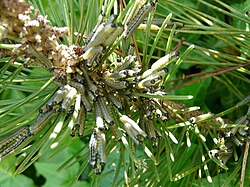| Neodiprion | |
|---|---|
 | |
| Neodiprion sertifer larvae on a pine in Dordogne France | |
| Scientific classification | |
| Kingdom: | Animalia |
| Phylum: | Arthropoda |
| Class: | Insecta |
| Order: | Hymenoptera |
| Suborder: | Symphyta |
| Family: | Diprionidae |
| Genus: | Neodiprion Rohwer 1918 |
| Species | |
See text | |
Neodiprion is a genus of sawflies in the family Diprionidae.